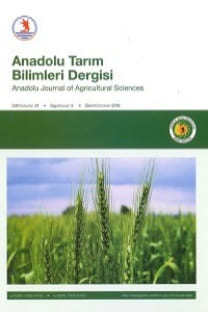Bitki koruma ürünlerinin kalıntı analizlerinde temel laboratuvar işlemlerinin ölçüm belirsizlikleri
Uncertainty measurement of basic laboratory operations in the residue analysis of plant protection products
___
- Anonymous, 1986. CRC Handbook of chemistry and physics 67th Edition F-4, F-5 CRC Press.
- Anonymous, 1995. Guide to the Expression of Uncertainty in Measurement, ISO, Geneva, 1995, ISBN92-67-10188-9. (Reprinted 1995).
- Anonymous 2000. EURACHEM/CITAC Guide CG 4. Quantifying Uncertainty in Analytical Measurements, 2nd Edtn. (QUAM:2000.P1) http://www. measurementuncertainty. org/mu /QUAM2000-1.pdf (Ulasım: 07.04.2008).
- Anonymous, 2004. ISO/TS 21748, Guidance for the Use of Repeatability, Reproducibility and Trueness Estimates in Measurement, 2004.
- Anonymous, 2005. EN ISO/IEC 17025, General requirements for the competence of testing and calibration laboratories, CEN Management Centre, Brussels.
- Anonymous, 2006. Quality control procedures for pesticide residue analysis, Document No SANCO/10232/ 2006, 24/March/2006.
- Anonymous, 2007a. Joint Comittee fr Guides in Metrology , International vocabulary of basic ande general terms in metrology(ISO), VIM3,Geneva, third ed.
- Anonymous 2007b. European Ccommission DG SANCO, Method validation and quality control procedures for pesticide residue analysisin food and feed, No SANCO/2007/3131/31 October 2007.
- Barwick, V.J., 1998. VAM Project 3.2.2 Evaluating Confidence in Analytical Measurement. Part (a): Literature review of uncertainty in laboratory operations. Review of sources of uncertainty in gas chromatography and high performance liquid chromatography. LGC/VAM/1998/053. Setting standards in analytical science.
- Benyhe, J., 1998. Testing the uncertainty of laboratory operations. In Pesticide residue analysis/Laboratory exercises “FAO/IAEA/SIDA Training Workshop on the "Quality Assurance and Quality Control Measures in Residue Analysis Laboratories” 2 March - 27 March Training and Reference Center for Food and Pesticide Control, Miskolc, Hungary.
- De Bièvre, P., 2007. The beginning of the end of the confusion in concepts and terms? The new international vocabulary of basic and general concepts in metrology (VIM). Accred. Qual. Assur., 12: 279-281.
- Hibbert, D.B., 2007. Systematic errors in analytical measurement results. J. Chromatogr A., 1158: 25- 32.
- Maestroni, M.B., 2005. Uncertainty of laboratory operations. In Lectures Database/Uncertainty of analytical results/Principles of estimation of uncertainty. FAO/IAEA Training Workshop on Introduction to QC/QA in Pesticide Analytical Laboratories, Training and Reference Center for Food and Pesticide Control, Seibersdorf, Vienna, Austria, 12 Sept- 7Oct 2005.
- Meyer, V.R., 2007. Measurement uncertainty. J. Chromatography A., 1158: 15-24.
- Shegunova, P., Bercaru, O., Olsen, B.S., 2008. Estimation of measurement uncertanty in organic analysid: two practical approaches. Accred. Qual. Assur., 13(1):11-18.
- Stepan, R., Hajšlová, J., Kocourek, V., Tichá, J., 2004. Uncertainties of gas chromatographic measurement of troublesome pesticide residues in apples employing conventional and mass spectrometric detectors. Analytica Chimica Acta, 520: 245-255.
- Tiryaki, O., Baysoyu, D., 2007. The Use of Radiotracer Techniques for QA/QC Principles in Pesticide Residue Analysis. Ankara Üniversitesi Ziraat Fakültesi, Tarım Bilimleri Dergisi, 13 (2):108-113.
- Tiryaki, O., Baysoyu, D., 2008. Estimation of efficiencies and uncertainties of the extraction and cleanup steps of the pesticide residue determination in cucumber using 14C-carbaryl. Accred. Qual. Assur., 13(2):91-99.
- Vanatta, L.E., Coleman, D.E., 2007. Calibration, uncertainty, and recovery in the chromatographic sciences. J. Chromatogr A, 1158: 47-60.
- Visi, E., 2002. Quality Assurance/Quality Control in pesticide residue laboratories. Possibilities of controlling the various analytical steps. FAO/IAEA Training and Reference Centre for Food and Pesticide Control Training workshop on Introduction to QC/QA measures in Pesticide Residue Analytical Lab. 17 June - 26 July IAEA’s Laboratories Seibersdorf; Austria.
- ISSN: 1308-8750
- Yayın Aralığı: 3
- Başlangıç: 1986
- Yayıncı: Ondokuz Mayıs Üniv. Ziraat Fak.
FAKTÖR A ALİZ SKORLARI KULLA ILARAK KARAYAKA KUZULARI DA CA LI AĞIRLIK TAHMİ İ
Soner ÇANKAYA, Aydın ALTOP, Ertuğrul KUL, Güray ERENER
BİTKİ KORUMA ÜRÜ LERİ İ KALI TI A ALİZLERİ DE TEMEL LABORATUVAR İŞLEMLERİ İ ÖLÇÜM BELİRSİZLİKLERİ
Use and comparison of permutation tests in linear models
TOKAT İLİ KÖY TAVUKÇULUĞU U BAZI ÖZELLİKLERİ
Ahmet ŞEKEROĞLU1, Şirvan AKŞİMŞEK
Faktör analiz skorları kullanılarak karayaka kuzularında canlı ağırlık tahmini
Soner ÇANKAYA, Güray ERENER, Ertuğrul KUL, Aydın ALTOP
Cem EGESEL, Fatih KAHRIMAN, Şemun TAYYAR, Harun BAYTEKİN
Tokat ili köy tavukçuluğunun bazı özellikleri
Ahmet ŞEKEROĞLU, Şirvan Dilan AKŞİMŞEK
Bahadır SAYINCI, Saim BASTABAN
Harun BAYTEKİN, Cem Ömer EGESEL, Fatih KAHRIMAN, Şemun TAYYAR
Bitki koruma ürünlerinin kalıntı analizlerinde temel laboratuvar işlemlerinin ölçüm belirsizlikleri
